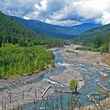Just weeks after receiving draft permits to mine for titanium dioxide and other minerals in Trail Ridge near the southeastern boundary of the Okefenokee National Wildlife Refuge, Twin Pines Minerals LLC now has a new foil that could derail the company’s mining plans: the U.S. Fish and Wildlife Service.
According to the Associated Press, the federal agency that manages the nearby refuge is asserting its claim on water rights in the region. The claim could be very problematic for the mine, which plans to produce about 1.5 million gallons of water a day from the Floridan aquifer, which is also the source for much of the water in the storied Okefenokee Swamp.
“Disruption to the natural flow of groundwater in this interconnected system could have far-reaching consequences for both the Refuge and surrounding areas,” Mike Oetker, the federal agency’s acting Southeast regional director, wrote in a Jan. 31 letter to Georgia regulators that was obtained by AP. “Any decision regarding the proposed mining permit must be made with consideration of federal reserved water rights.”
With draft permits in hand and a public comment process on those permits that expires April 10, 2024, Twin Pines is now waiting for official permits to dig its mine. The next move will be made by the Georgia Environmental Protection Division, the agency that issued the draft permits on Feb. 9, 2024. But, with the USFWS on the record asserting its rights to the water in the Floridan aquifer to protect the refuge, the GEDP could be hamstrung.
The state agency must work with the USFWS to resolve any water rights claims – a 1908 Supreme Court ruling established that federal water rights take precedence over other water rights claims on public lands managed for Indigenous tribes, national parks and other uses.
The move by the federal agency is the latest attempt by the U.S. Department of Interior to show its disapproval of the effort to mine for heavy sands along one of the natural water barriers of the refuge, which contains the largest wilderness area in the Southeast United States (354,000 acres). In December 2022, Secretary of the Interior Deb Haaland wrote a letter to Gov. Brian Kemp, asking him to preemptively stop any mining activity on the fringes of the Okefenokee, citing the swamp’s environmental and cultural significance to the region.
Prior to the summer of 2022, the U.S. Army Corps of Engineers was responsible for the oversight of the mine permitting process and, in June of that year, the Corps actually revoked a permit it had originally awarded to Twin Pines to mine near the refuge. But that changed when Twin Pines successfully sued the Corps, using the new Clean Water Act guidance issued during the Trump administration that removed protections from headwater streams and wetlands under the contentious Waters of the U.S. Rule. Oversight returned to the smaller and leaner GEPD which did exactly what Twin Pines wanted it to do last month when it issued the draft permits for the mine.
And those permits were awarded despite about 160,000 public comments received by the GEPD during the public comment process last year. Oddly, GEPD acknowledged the difficulty it had (and will have as the next round of public comments continues until April 10) in receiving or even reading all the comments it received because of the excessive traffic endured by its online comment portal.
"Due to the high volume of emails sent to this account, you may receive a bounce-back notification," the GEPD’s comment portal warns those seeking to provide input into the mining permit process.
What happens next? The 60-day public comment period ends April 10. At some point after that date, GEPD will review all received comments (minus those its system couldn’t handle, of course) and either make the draft mining permits official or it could unexpectedly change course altogether and revoke the draft permits.
Should the state division move forward with the permits, it’s a safe bet that the USFWS will fall back on its water rights claims, which will make it all but impossible for Twin Pines to mine (the “produced” water isn’t optional – the water table along the Florida-Georgia border is sometimes just a couple of feet beneath the dirt).
Unable to mine heavy sands without producing water, Twin Pines may have no other recourse than to pursue its options in court. This is an outcome that, for many in the south Georgia area who value the swamp for its fish and wildlife resources and its cultural assets (the refuge is a candidate for designation for the World Heritage List maintained by the United Nations Environmental, Scientific and Cultural Organization) would be a welcome delay in the mining process.
One important note. The federal agency that nominated the Okefenokee for UNESCO designation? The National Park Service. Like the USFWS, the NPS is under Department of Interior Oversight.
“The Department has a profound interest in protecting the health and integrity of the swamp ecosystem,” Haaland wrote to Kemp in December 2022. “Home to the refuge, it is a unique wetland ecosystem unlike any other found in North America and is one of the world’s most hydrologically intact freshwater ecosystems.”
One might infer, both from Haaland’s plain-language letter to Kemp, and from the involvement of the USFWS and the NPS, that, as long as Haaland is at the helm of Interior, the Okefenokee National Wildlife Refuge will be spared from the mining dragline.






























Comments